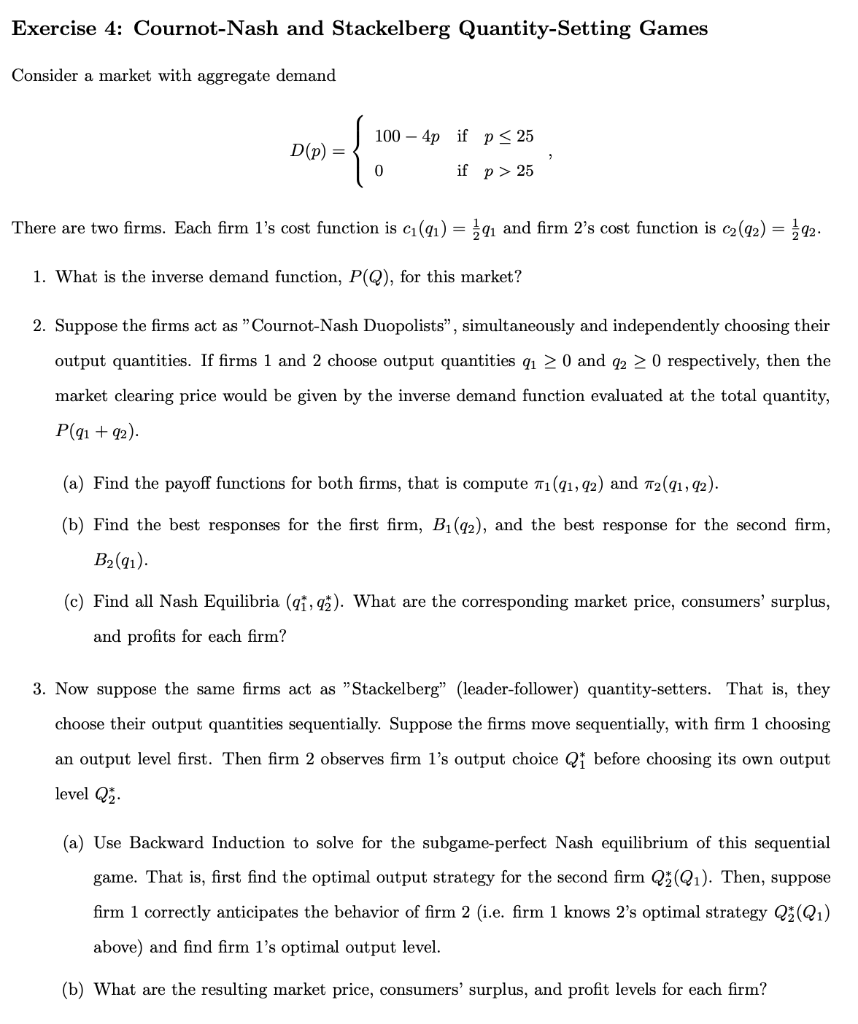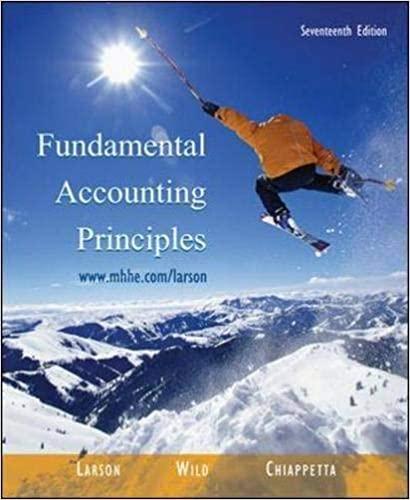
Exercise 4: Cournot-Nash and Stackelberg Quantity-Setting Games Consider a market with aggregate demand D(p)={1004p0ifp25ifp>25 There are two firms. Each firm 1's cost function is c1(q1)=21q1 and firm 2's cost function is c2(q2)=21q2. 1. What is the inverse demand function, P(Q), for this market? 2. Suppose the firms act as "Cournot-Nash Duopolists", simultaneously and independently choosing their output quantities. If firms 1 and 2 choose output quantities q10 and q20 respectively, then the market clearing price would be given by the inverse demand function evaluated at the total quantity, P(q1+q2). (a) Find the payoff functions for both firms, that is compute 1(q1,q2) and 2(q1,q2). (b) Find the best responses for the first firm, B1(q2), and the best response for the second firm, B2(q1). (c) Find all Nash Equilibria (q1,q2). What are the corresponding market price, consumers' surplus, and profits for each firm? 3. Now suppose the same firms act as "Stackelberg" (leader-follower) quantity-setters. That is, they choose their output quantities sequentially. Suppose the firms move sequentially, with firm 1 choosing an output level first. Then firm 2 observes firm 1's output choice Q1 before choosing its own output level Q2. (a) Use Backward Induction to solve for the subgame-perfect Nash equilibrium of this sequential game. That is, first find the optimal output strategy for the second firm Q2(Q1). Then, suppose firm 1 correctly anticipates the behavior of firm 2 (i.e. firm 1 knows 2 's optimal strategy Q2(Q1) above) and find firm 1's optimal output level. (b) What are the resulting market price, consumers' surplus, and profit levels for each firm? Exercise 4: Cournot-Nash and Stackelberg Quantity-Setting Games Consider a market with aggregate demand D(p)={1004p0ifp25ifp>25 There are two firms. Each firm 1's cost function is c1(q1)=21q1 and firm 2's cost function is c2(q2)=21q2. 1. What is the inverse demand function, P(Q), for this market? 2. Suppose the firms act as "Cournot-Nash Duopolists", simultaneously and independently choosing their output quantities. If firms 1 and 2 choose output quantities q10 and q20 respectively, then the market clearing price would be given by the inverse demand function evaluated at the total quantity, P(q1+q2). (a) Find the payoff functions for both firms, that is compute 1(q1,q2) and 2(q1,q2). (b) Find the best responses for the first firm, B1(q2), and the best response for the second firm, B2(q1). (c) Find all Nash Equilibria (q1,q2). What are the corresponding market price, consumers' surplus, and profits for each firm? 3. Now suppose the same firms act as "Stackelberg" (leader-follower) quantity-setters. That is, they choose their output quantities sequentially. Suppose the firms move sequentially, with firm 1 choosing an output level first. Then firm 2 observes firm 1's output choice Q1 before choosing its own output level Q2. (a) Use Backward Induction to solve for the subgame-perfect Nash equilibrium of this sequential game. That is, first find the optimal output strategy for the second firm Q2(Q1). Then, suppose firm 1 correctly anticipates the behavior of firm 2 (i.e. firm 1 knows 2 's optimal strategy Q2(Q1) above) and find firm 1's optimal output level. (b) What are the resulting market price, consumers' surplus, and profit levels for each firm







